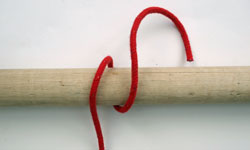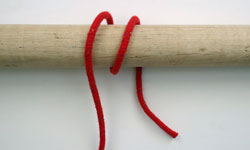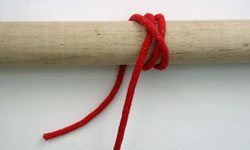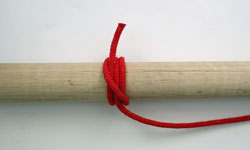- Home
- Essential Knots
- Rolling Hitch
Learn the Rolling Hitch: A Guide to Attaching Lines Under Load
In a Nutshell...
The rolling hitch is a crucial knot for sailors, designed to attach a line to a rope or spar under load. Its primary advantage is its ability to hold securely without slipping, even when the load is intermittent or the surface is smooth. It's an indispensable skill for tasks like rigging a temporary sheet, creating a stopper for a line under tension, or creating a temporary tow bridle.
This guide provides a straightforward, step-by-step method for tying the knot, along with practical, real-world applications for both new and experienced sailors.
Table of Contents
Why the Rolling Hitch is a Sailor's Best Friend
As any offshore sailor knows, things don't always go to plan. From a chafe-worn sheet that's about to part to a line that's slipped off a winch, you often need to attach a new line to one that's already under tension. This is where the rolling hitch comes in. Unlike a clove hitch, which can slip under an uneven load, the rolling hitch is designed to grip tight on a smooth surface like a rope or mast. It's a skill I've relied on countless times, from creating a temporary line to ease a jammed headsail furler to fashioning a jury-rigged preventer in a rolling sea.
How to Tie the Rolling Hitch: A Step-by-Step Guide
- Form the First Turn: Begin by taking your working line and wrapping it around the standing line (the one under load). The first wrap should be over the standing line, forming a simple turn.
- Add a Second, Parallel Turn: Immediately after the first turn, make a second wrap that runs parallel to it, going in the same direction. These two turns are the foundation of the knot's grip.
- Cross Over & Tuck: Now, bring the working line over the two parallel turns, creating an "X" shape. Pass the working line underneath the standing line and through the loop formed by the crossover.
- Tighten & Test: Gently pull on the working end to snug the knot down. It should slide easily along the standing line until a load is applied, at which point it should hold firm. It's always good practice to test the knot with a small load before trusting it fully.
- Expert Tip: For added security on a slick surface or in high-stakes situations, you can add an extra parallel turn in step 2. This creates a three-turn rolling hitch, which I've found to be particularly effective on wire or very smooth synthetic lines.
For the purpose of the illustrations we've employed a wooden spar, but it could similarly have been a stanchion, rail, guardwire or taught rope.

Stage 1
Take a turn around the spar...

Stage 2
... followed by a second one;

Stage 3
Now take another turn back in the other direction over the first two turns...

Stage 4
...and tuck the working end back under itself.
The rolling hitch will move along the spar if pushed by hand, but trying to move it by pulling on the standing part of the line will get you nowhere.
Practical Applications on the Water
The rolling hitch is incredibly versatile. Here are a few common scenarios where this knot will be your go-to:
- Creating a temporary sheet or halyard: If a sheet is chafed and you need to get a new line on it without releasing the tension, you can use a rolling hitch to attach a spare line further up the sheet and transfer the load.
- As a "stopper" knot: You can use a rolling hitch to stop a line from running out of a block or fairlead. Simply tie the hitch on the line and let it jam against the fitting.
- Preventer or temporary bridle: On 'Alacazam', my 38-foot cruiser, I once used a rolling hitch to attach a preventer to the boom in a sudden squall. It held fast and prevented an accidental jibe, a testament to its reliability.
- Assisting a winch: If a line is difficult to winch in by hand, a rolling hitch can be used to attach a second line, allowing you to use another winch or to a block for more purchase.
- Creating an anchor snubber: When anchored in a strong current or high winds, a rolling hitch is perfect for attaching a snubber line to your anchor rode. This helps absorb shock loads and reduces chafe on your anchor line at the bow roller.
For a complete overview of knots and splicing, including their history and uses, return to our main article: A Sailor's Guide to Essential Knots & Splicing.
By Dick McClary, RYA Yachtmaster Offshore & member of the Yachting Journalists Association (YJA)
Frequently Asked Questions (FAQs)
Is the rolling hitch a secure knot?
Is the rolling hitch a secure knot?
Yes, it's one of the most reliable knots for attaching a line to a rope or spar under tension, provided it is tied correctly and the turns are snug.
Can I use this hitch on a mast or boom?
Can I use this hitch on a mast or boom?
Absolutely. It is designed to grip cylindrical surfaces and is often used to attach lines to a mast or boom.
How is it different from a clove hitch?
How is it different from a clove hitch?
The main difference is in the number of turns and their configuration. The rolling hitch's two parallel turns provide a superior grip under an uneven or changing load, while a clove hitch is more prone to slipping in those conditions.
What if the line I'm tying onto is greasy or wet?
What if the line I'm tying onto is greasy or wet?
A well-tied rolling hitch is still effective on wet lines. For greasy or extremely slick lines, adding an extra parallel turn (creating a three-turn rolling hitch) will significantly increase the friction and security of the knot.
Sources
https://www.animatedknots.com/rolling-hitch-knothttps://www.sailingtoday.co.uk/tutorials/how-to-tie-a-rolling-hitch/https://www.rya.org.uk/knowledge-advice/boating-tips/knots-splices-ropework
Recent Articles
-
Modern Boat Electronics and the Latest Marine Instruments
Dec 20, 25 05:27 PM
Should sailboat instruments be linked to the latest boat electronics as a fully integrated system, or is it best to leave them as independent units? -
Hans Christian 43: Classic Bluewater Cruiser & Liveaboard Sailboat
Dec 10, 25 04:37 AM
Explore the Hans Christian 43: a legendary heavy-displacement, long-keel sailboat. Read our in-depth review of its specs, design ratios, and suitability for offshore cruising and living aboard. -
Planning Your Sailboat Liveaboard Lifestyle: An Ocean Sailor's Guide
Dec 06, 25 05:18 AM
Seasoned sailors share their methodical risk analysis for planning a secure Sailboat Liveaboard Lifestyle, covering financial, property, and relationship risks.












